The view from my balcony.
Written by: Bea Combs-Hintze (PhD student with Drs. David Naar & Steve Murawski).
The first step is getting there –
I opened up the French doors to the patio, where I was hit with the perfume of plumeria blooming, and heard the strange calls of new birds. I saw lush greenery and volcanic peaks. I felt the presence of something familiar, an ocean. But there was also a distinct newness. I found myself in the Southern Hemisphere autumn, about 10,000 miles from Florida’s spring. A shock to the senses! My toddler, T, was sleeping soundly in the next room. It was just me and him in an otherwise empty apartment. I beamed with pride that I carried him here safely, over so much planet, in what seemed like the blink of an eye.
I took a moment to bring myself down from the stratosphere, to quiet the dizziness of all the travel and planning that took place to get to this point, and to take in the reality around me. The reason I was here was to attend my first international conference, called GeoHab, focused on geological and biological habitat mapping in the marine environment. It was thrilling to think that people from around the world would soon be in a room where I would be presenting to hear about my work.
We were in La Réunion – an island in the Indian Ocean that is part of the Mascarene Islands and the African continent, but an overseas department of France about 679 km east of Madagascar. I was in Saint-Gilles, which is 45 minutes southeast of the largest city and location of the airport, Saint-Denis. Nowadays, this outermost area of the European Union has a population which is a rich mixture of many descendants, the predominant language being Réunion Creole. I found that my intermediate French was most useful here, a variety of dialects and accents meant that people were accustomed to a variety of flavors of the language. I was in awe that I made a random decision to study French all those years ago and was now using it on a trip that would prove to be a cornerstone in my life.
Travel was long and strenuous. I hadn’t gotten much sleep for the past 30 hours, there were trains (including the Chunnel that jettisoned us under the English Channel to Paris for our connecting flight to Reunion!), buses, cars, and planes! The dimension of having a tiny life that I was solely in charge of through it all was catching up to me physically, my eyes felt puffy and heavy. I splashed them with cold water and smiled up at myself in the mirror, Reunion water! As oceanographers we know that the water in the Southern Hemisphere does not run the other direction down the drain, that is a phenomenon reserved for large bodies of water due to the Coriolis effect. Hurricanes are called cyclones and are counterclockwise south of the equator. This was information that I was to report back to certain non-science friends back home. My brain was buzzing with these tidbits!
I was running on fumes, and soon delicious Reunion coffee.
What was truly driving my body forward in space was this amazing opportunity that I had been granted, the beauty of this experience — how crucial it was. How much it would advance the career that I had been fighting my way through for the good part of a decade!
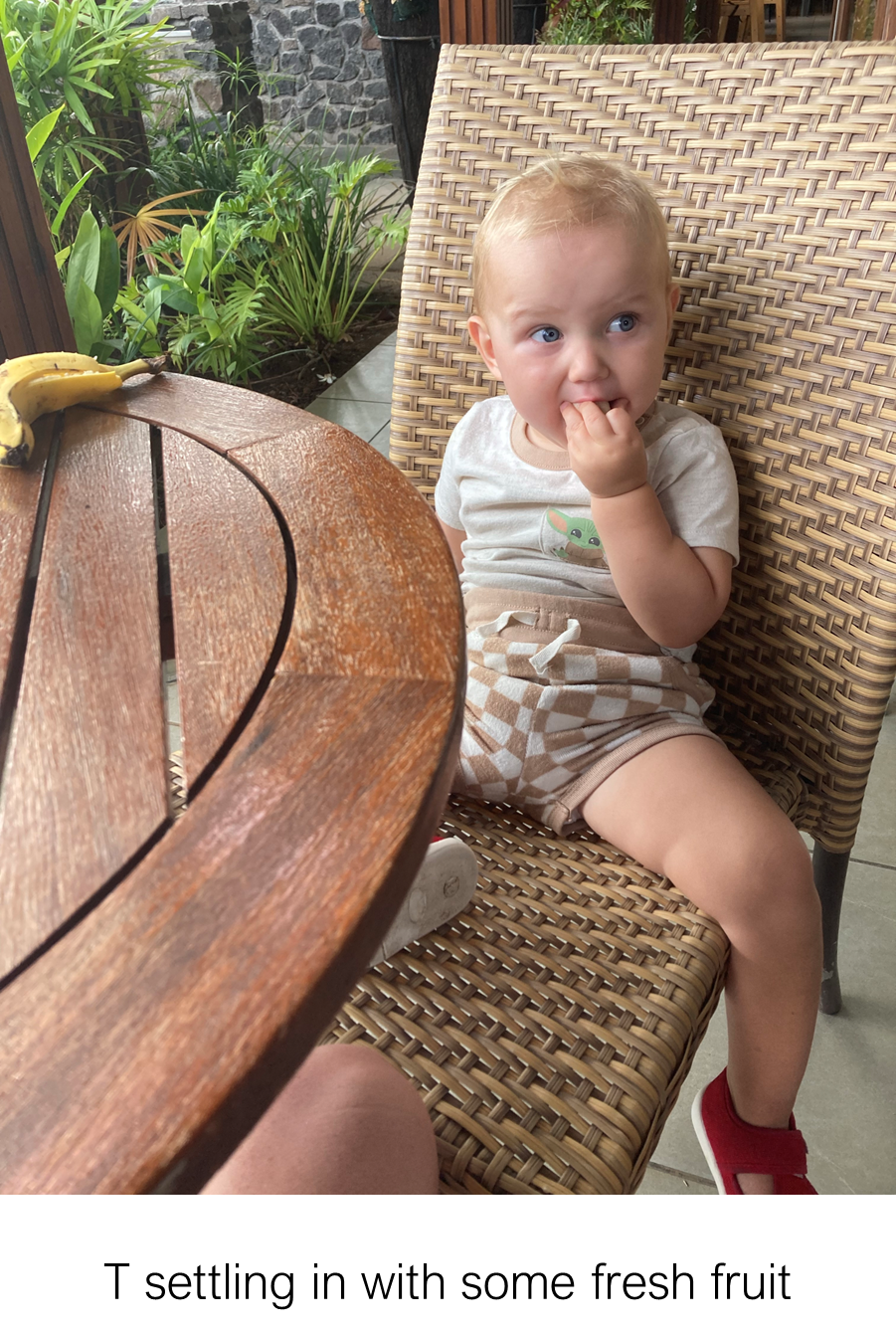
After stretching, thanking, and sinking back to Earth, I took the rustles in the next room as my cue to greet my small travel buddy and get him ready for the day. He would also need some time to get grounded. We were meeting up with a sitter who was hired by the conference to take care of T and a 22-month-old from LA. I had to pinch myself again… I was at a conference, where I was funded to participate (and talk!) as a student, and I have the essential component of childcare covered, so I could do my work and be close to the kid that still very much needs me. The whole situation seemed too good to be true — but this is truly what is required to support early career scientists and widen the arena of people participating in the research world.
The first step — is getting there!
Once T was settled in and speaking French with the lovely sitter, I made my way through coconut trees to the conference hotel across the street.
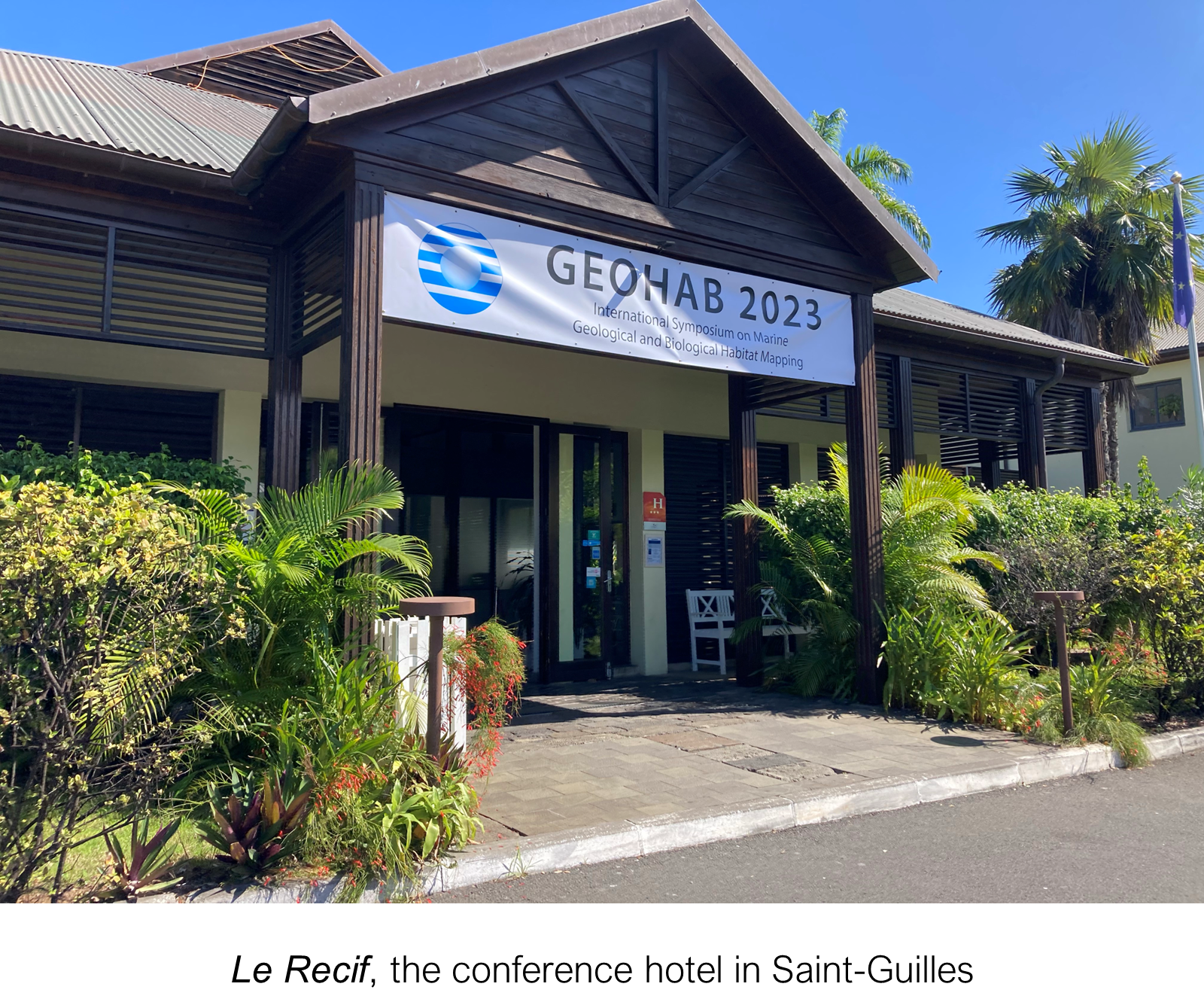
I was greeted by the team of people who had only been email handles up to this point. Immediately I felt at home. Mixing and mingling, chatting over coffee and fresh pineapple juice. There were people from academia and industry who I’ve admired for some time, as well as new acquaintances made up of younger scientists with whom I had instant connections.
The Science
After introductions we immediately got into the science that binds us. New sonar technology, ways of parsing through data, harnessing artificial intelligence, defining habitat, and making maps that can be shared far and wide. At the poster session the night before, I was able to scope out my fellow seagrass people, taking every chance to chat the ways in which they were locating and mapping our favorite (and the only) marine angiosperm — a flowering plant. My notes span pages and this blog post could be a novel about the fascinating science that I heard and saw.
I was deeply inspired by the “NOMANS_TIF” map, Ireland’s first complete shallow seabed geomorphology map. One of the most ambitious seabed mapping programs in the world where about 780,000 km2 of seafloor has been surveyed in high resolution This program used modern machine assisted mapping to streamline and standardize results, and I envisioned us using similar procedures on our data of the West Florida Shelf.
Another group presented on combining optical and acoustic data in the Arctic and Antarctic, which looked at how slope and surface structure influenced benthic communities. In doing this, they discovered the largest fish nesting colony (upwards of 60 million nests!) in the Antarctic and mapped for sponge grounds in the High Arctic for the first time. This sort of pure discovery in some of the more extreme environments on Earth is the ‘moon shot’ type of energy that keeps us powering forward in our field.
A fellow student, Emmelie Broad of Newfoundland, used machine learning to predict migration of bottom dwelling creatures by using a unique model structure that was able to combine two very different data types, the geomorphology of the sea floor and changes to the earth’s climate. We both wrestle with various big data sets to answer ecology questions, and came up to each other to mention the notes we took of each other’s talks, and in doing so made a lifelong research friend and potential future collaborator.
I told the story of seagrass in Tampa Bay — at least what is written so far. My work is built on mountains of available seagrass transects (study lines that measure a sample of an environment) that have been conducted in Tampa Bay since the 80s. The growing body of knowledge about the water quality boosting power of seagrass, led us to seek restoration after a near complete loss — by planting masses of grasses. There were also regulations set on fertilizer.
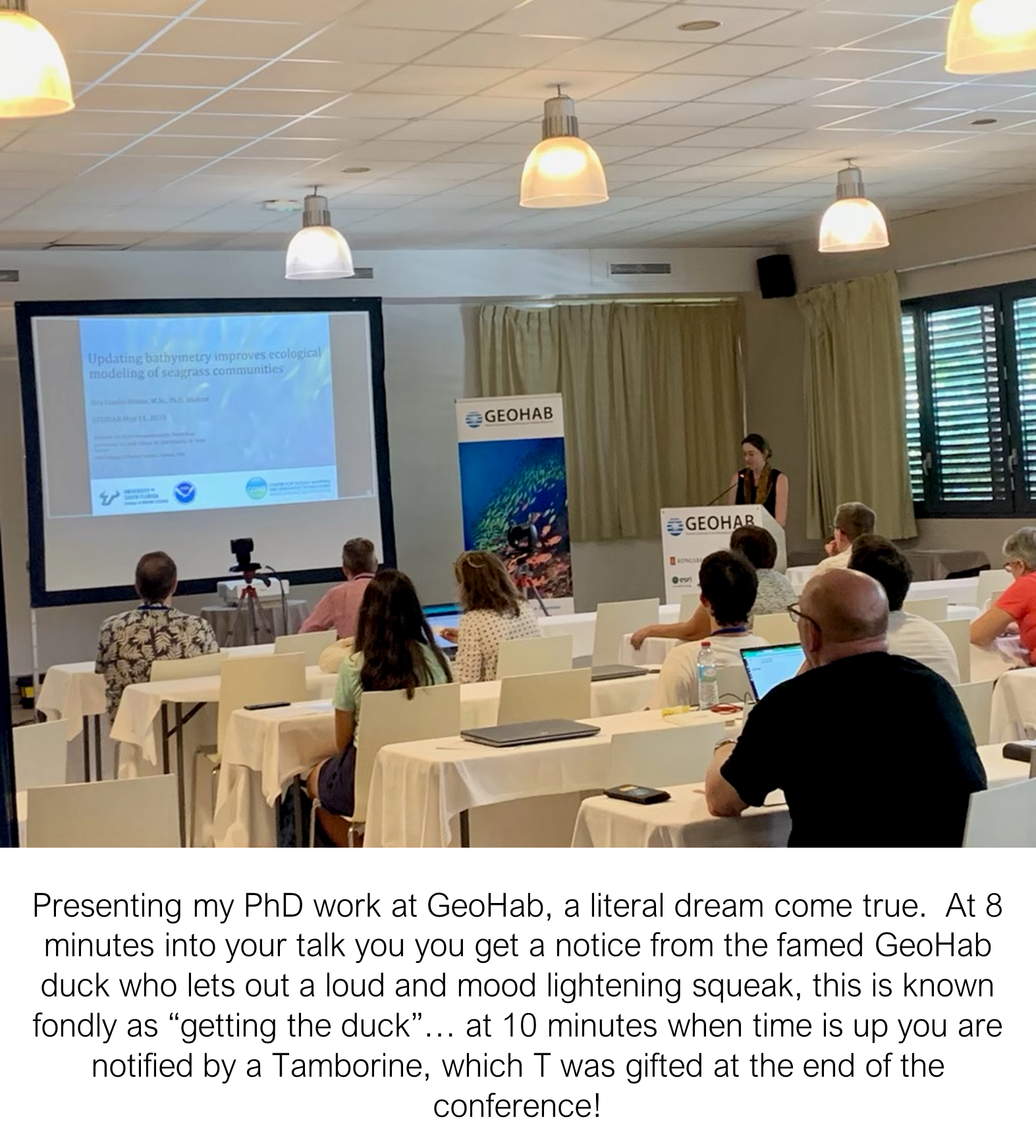
The meadows were restored to near historic levels, bringing economy boosting fish (many game fishes nurseries are seagrasses), turtles and manatees back to the Bay. However, a few years ago the diligent monitoring efforts began to notice significant losses, especially in the upper portions of the Bay. We are realizing that it will take more than nutrient and water quality control to maintain the resiliency of seagrass and their associated species. There are other threats: population increases along the coast lead to overdevelopment and excess unfiltered freshwater which impacts its preferred salinity; sea level rise reducing light needed by the plants to photosynthesize; scaring of meadows from the propellors of an increasing number of boats. There is also point source pollution like the Piney Point disaster, an abandoned mine that discharged waste into the bay after a massive storm. This led to huge cyanobacteria and dinoflagellate (or, red tide) blooms that blocked sunlight, starved oxygen, and even in the case of red tide, added a toxin to the water which killed fish and other species. There is also a lot of fish data that can be linked to seagrass. I am working on an ecological model that ties all of these characters and themes together, it builds off of where we have been, in order to take a guess at where we might be headed. By adding more details about the bathymetry, or features of the sea floor, as well as other creature communities that are linked to seagrass, I can better understand the spatial patterns and the details that help meadows thrive.
The conference breathed life into my research, it provided ember for conversations I would have not had otherwise, stoked the flames of ideas that had been glimmering in the back of my head for a while. It propelled me forward in my writing and in future career opportunities that I didn’t know existed. I was shown the importance of not only (safe/thoughtful) in-person meetings, but the unquantifiable value of simply the chance and support to attend. This chance was awarded to me before I made my mark in the field, before the financial ability to take myself there, before I was 10+ publications in, before I had my Ph.D. This chance awarded me the potential to make myself into somebody whose work is contributing to this effort, and made the up-hill climb to that place easier by providing some handrails.
The Experiences
The last conference day was an optional field trip to Piton de la Founaise, “Peak of the Furnace,” an active volcano on the southeast corner of the island. I had been training since T was born to carry him strapped to my back or front and I knew with 100% confidence that this was something that I had to partake in. We left at 6am on a charter bus for the park, where we met up with Reunion geologists and the best packed lunch I have ever consumed (leave it to the French to have all three sides be a delicious form of carb). This volcano rises more than 2,631 m above sea level (so we had to dress warmly).
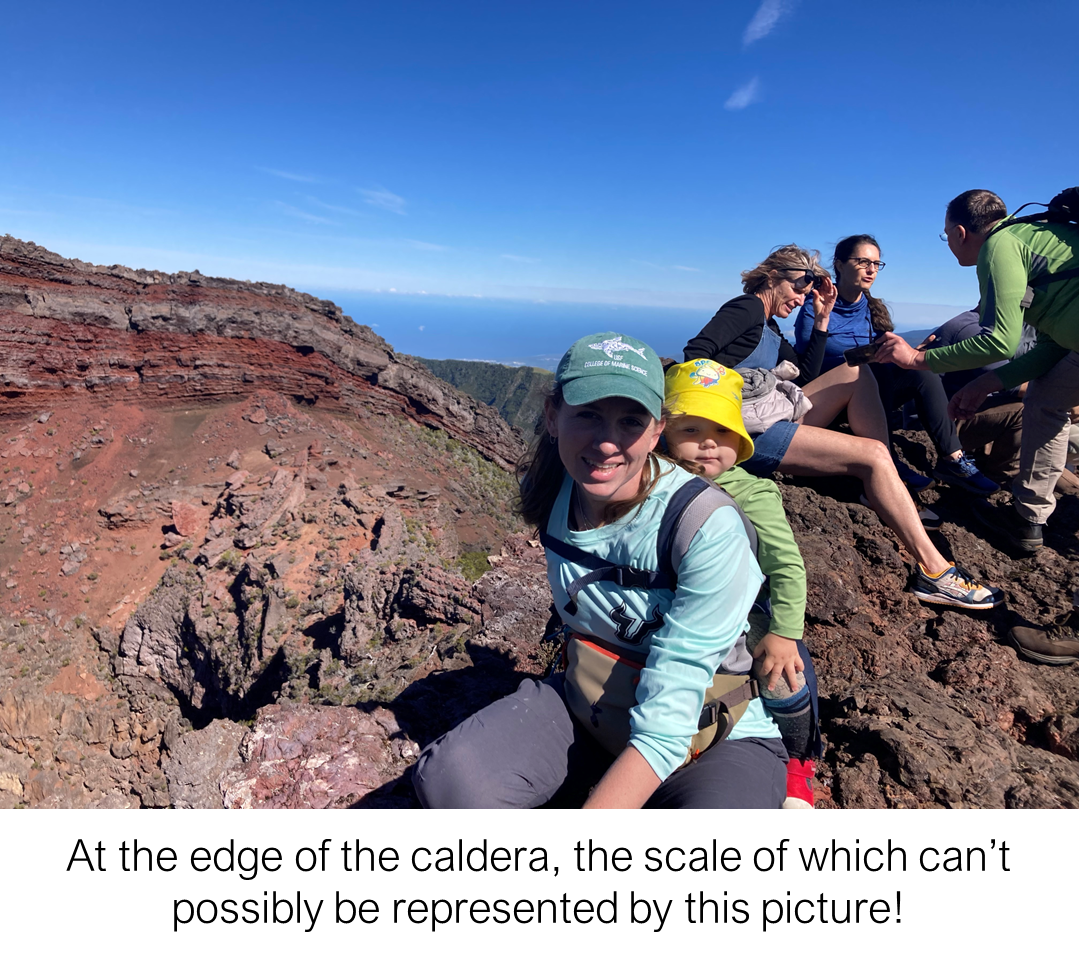
I had to reach back into my mental geological oceanography files to remember what a shield volcano (like this one) was… a.k.a., the “safe” kind. Relatively frequent, slow-moving eruptions cause the “shield” like shape due to a a steady accumulation of sheets of lava. Occasionally these lava flows reach the sea, but hasn’t in a while here. We were able to see lava flows from the last eruption — December 20, 2020. We didn’t get to do the 7-mile hike to the mouth of the volcano, but we got to explore the uppermost section of the volcano which is occupied by the Enclos Fouqué, a caldera 8 kilometers (5.0 mi) wide. High cliffs, known as remparts in French, form the caldera’s rim. We hiked down a steep path (that thankfully had smooth pine handrails for added saftey) toward the crater at the bottom, Cratère Dolomieu. This was formed when lava with a lot of iridium was ejected from the vent. The first crater we explored was a smaller one called Formica Leo… because it is similar looking to the trap formed by antlions, small insects whose larvae dig small holes to trap prey. It was an exhilarating hike on a Mars-like landscape, and an excellent time to be surrounded by geologists.
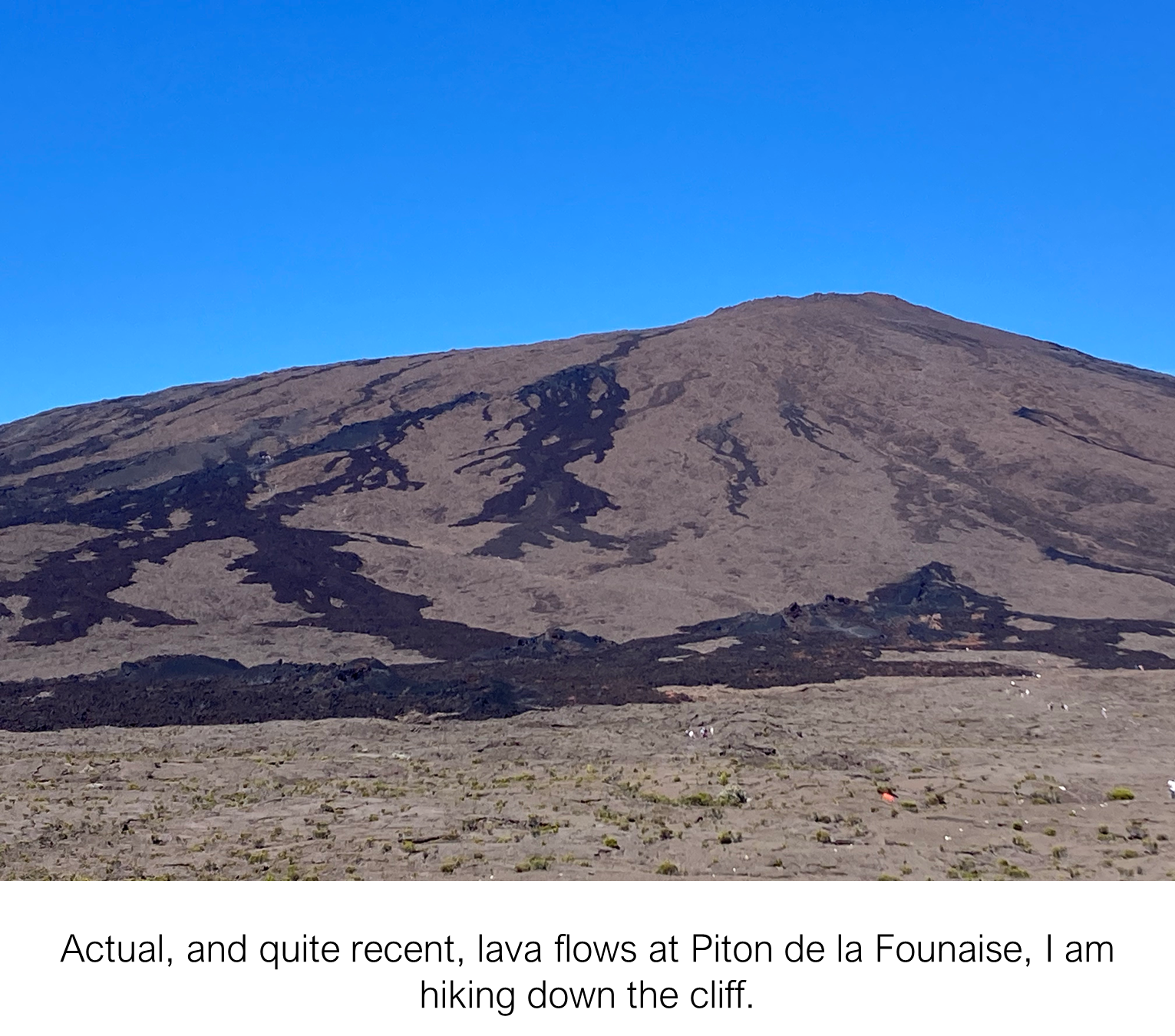
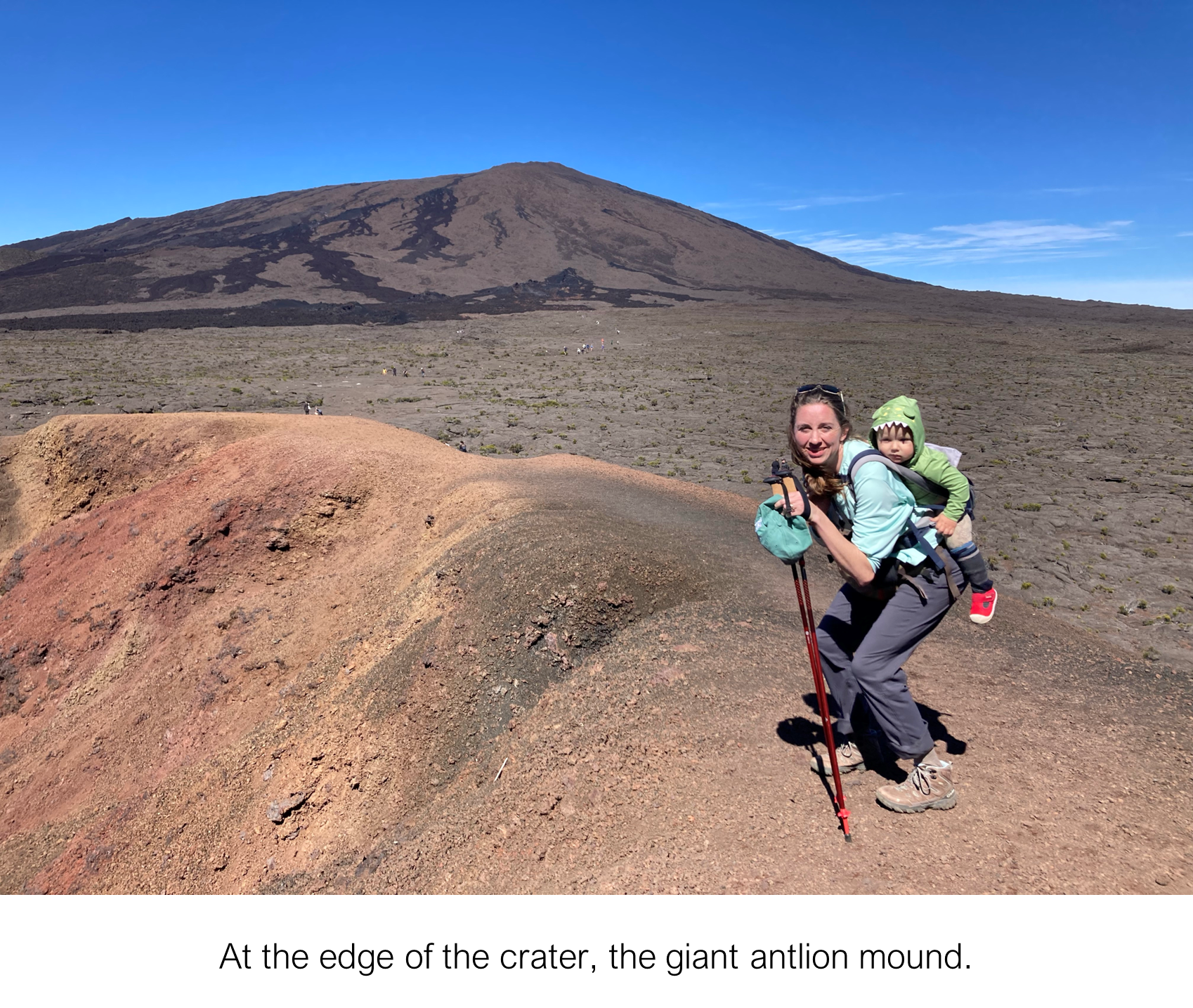
I was able to take a few trips into town to go food shopping au marché. I subsided on fruit, bread, local cheese and a good helping of affordable and delicious wine. On my way home one night, with way too much food for one adult and child in tow, I met wonderful locals who shared beer and Reunionese curry chicken — slow roasted in a pit with honey and cardamom among other spices — by the beach. We talked about the history of the island and what it meant for everyday life, French ownership, the culture, food…and more!
I was extremely appreciative to learn more about the history of the island and the people who call it home. This island was uninhabited until French colonists settled in the 17th century. The climate led to plantation economy with slaves imported from East Africa, followed by indentured labor from Malaysia, Vietnam, and China. Slavery was abolished on December 20, 1848, an important holiday on the island.
I learned that even after slavery was abolished, there was a lot of human exploitation to maintain plantation farming. Crops were coffee (which was not cyclone-resistant), sugar (which was cyclone-resistant), hand-pollinated vanilla, and eventually geranium (an ingredient in perfume and also mosquito repellant… a necessary item there). When the Suez Canal was built, it was a less important trade stop, and had to re-think its economy and the address the people whose backs it was built on. This was a massive shift. Creole governors were appointed in the late 1800s to make the decisions. The culture of the island came to be one of unity and focus on the quality of life for those living there. Roads were built and the island became a self-sufficient paradise. Now, according to the locals that I met, there are a variety of religions and cultures and little sense of one group taking precedence over another since the turn of the last century.
T played with dogs and pointed at Tropicbirds sailing overhead. There were excellent cases presented as to why I should move and study oceanography there. I fielded questions about my research and home state in my best possible “Franglish.”
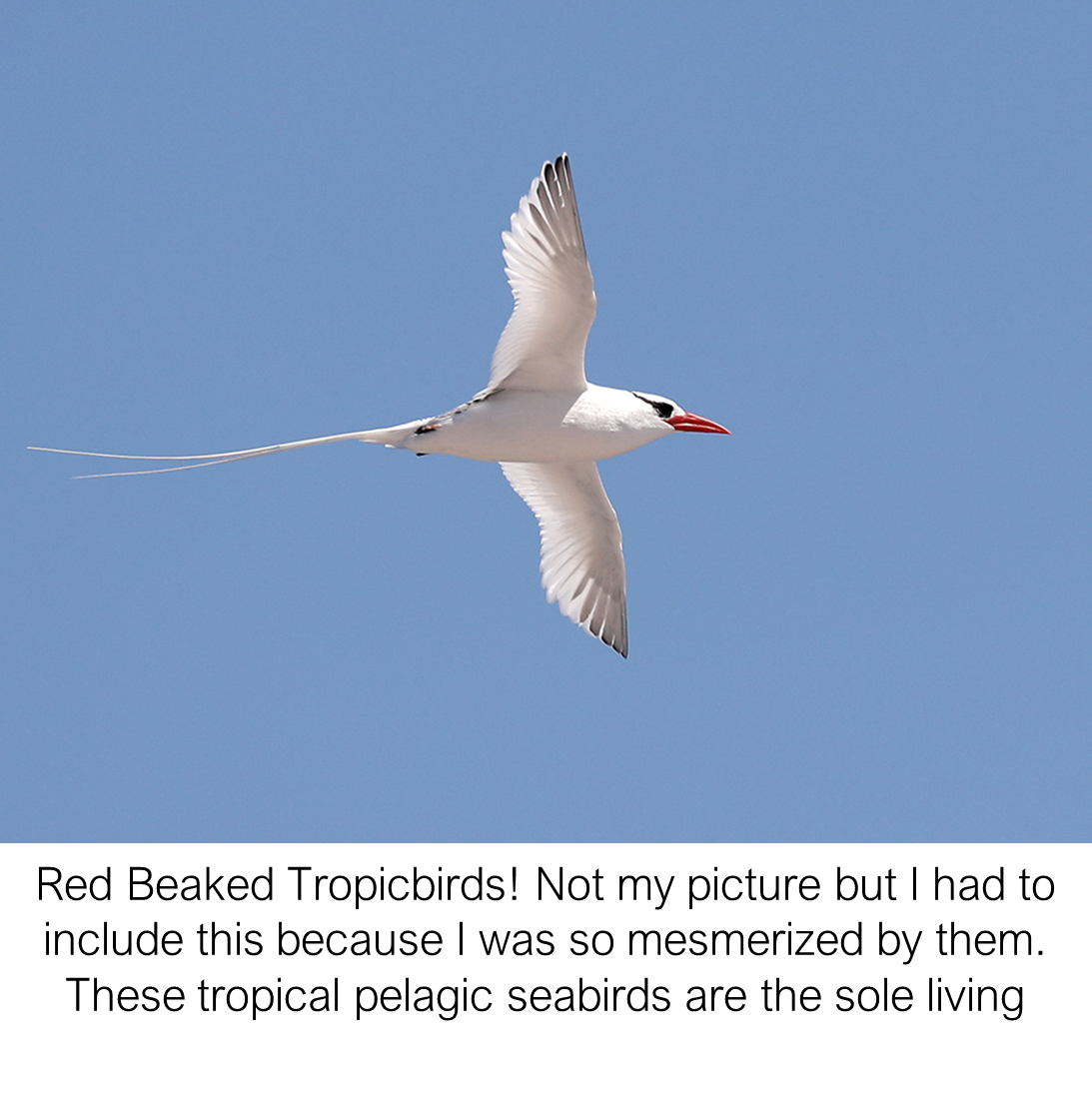
Reflections, and the way forward
My last night was bittersweet. We had a good long swim in the shallow lagoon, located tiny bits of a variety of coral species in the sand. I watched Scorpio and all the southern hemisphere stars that made me feel like I was on another planet rise above us. I drank the best cocktail of my life. I washed clothes and hung them to dry in the cool night air. I was so ready to get home to my partner, family, and friends. I was eager to plunge back into my research. But I was not ready to leave this world. The international platform of researchers who showed me the way future generations could be so intricately and perfectly weaved into our work. The dedication to exploration and mapping for the sake of humanity. The gorgeous and welcoming tropical paradise, the unique culture, and stunning wildlife. The key was getting there, and it opened up a treasure trove of possible futures.
Looking around at this group of dedicated, inspiring scientists, I saw my future self. I saw women with 10-year-olds in tow, making important discoveries and contributing to the literature. I saw people reaching out horizontally and taking their students from a variety of diverse backgrounds to a volcanic summit. I saw a group of people from all over the world who saw value in playing the long game, and the quality of the talks, rich collaborations, and state of art technology showed that it was working out well. I saw people united in a mission of mapping habitat and seafloor of the entire world’s oceans by 2030, representing so many countries, bringing their unique expertise and interests into the room. The view was stunning in more ways than one.
Liberté, égalité, fraternité! Liberty, equality, friendship (And science!)
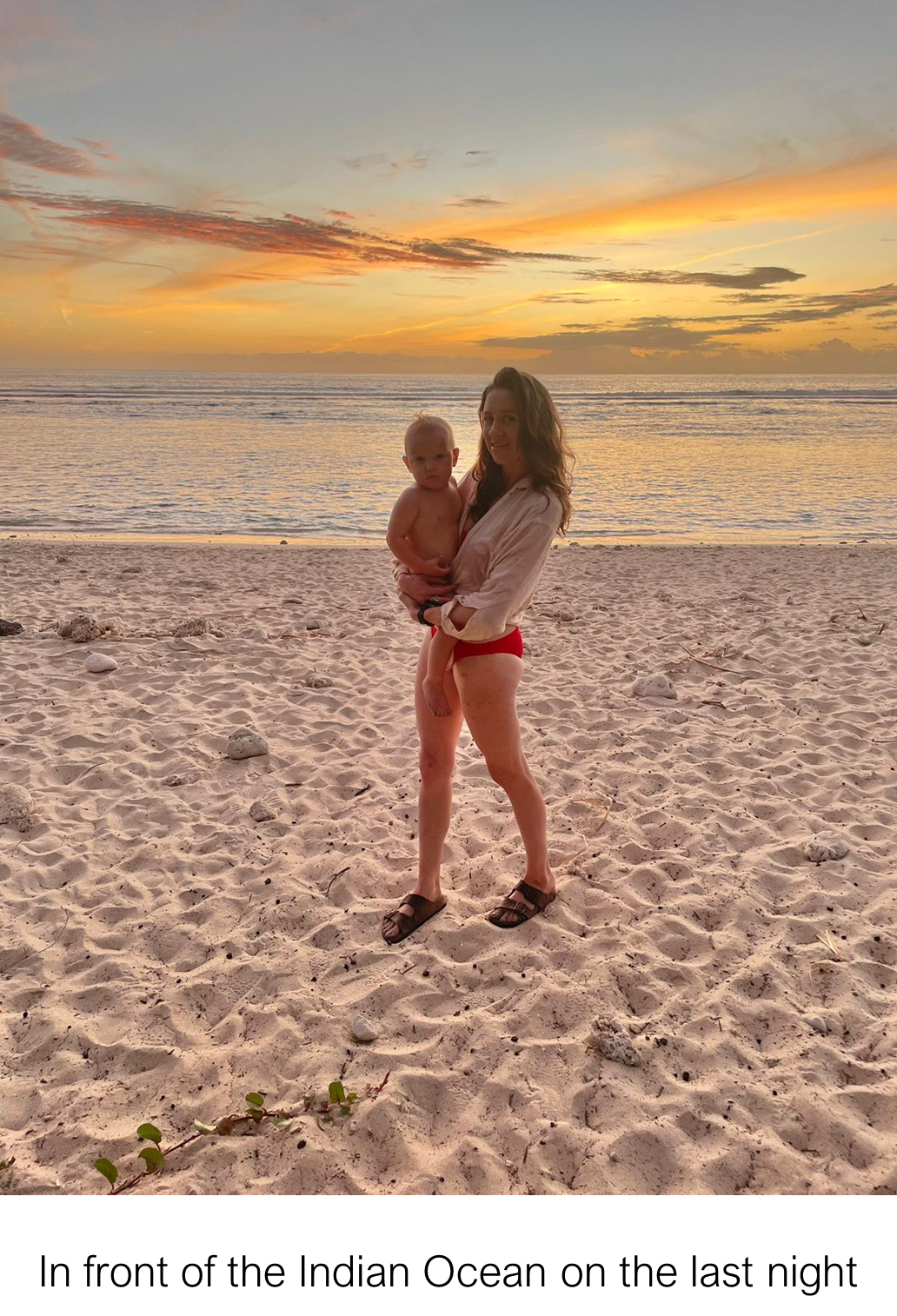
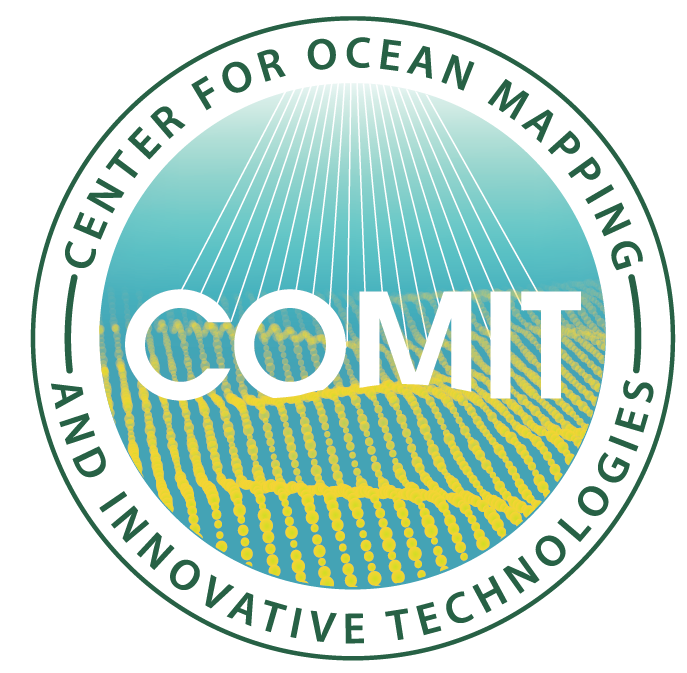
Recent Comments